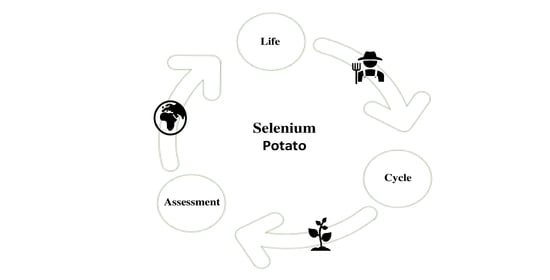Life-Cycle Assessment of Biofortified Productions: The Case of Selenium Potato
Abstract
1. Introduction
2. Materials and Methods
2.1. Biofortified Products and the Evolution of Consumption Patterns
2.2. Selenium Potato Life-Cycle Assessment
3. Results and Discussion
4. Conclusions
Author Contributions
Funding
Data Availability Statement
Conflicts of Interest
References
- FAO; IFAD; WFP. The State of Food Insecurity in the World 2012: Economic Growth is Necessary but not Sufficient to Accelerate Reduction of Hunger and Malnutrition; Food and Agriculture Organization of the United Nations; International Fund for Agricultural Development; World Food Programme: Rome, Italy, 2012. [Google Scholar]
- Bryce, J.; El Arifeen, S.; Pariyo, G.; Lanata, C.F.; Gwatkin, D.; Habicht, J. Reducing child mortality: Can public health deliver? Lancet 2003, 362, 159–164. [Google Scholar] [CrossRef]
- Alderman, H.; Hoddinott, J.; Kinsey, B. Long term consequences of early childhood malnutrition. Oxf. Econ. Pap. 2006, 58, 450–474. [Google Scholar] [CrossRef]
- Kennedy, G.; Nantel, G.; Shetty, P. The scourge of “hidden hunger”: Global dimensions of micronutrient deficiencies. FNA/ANA 2003, 32, 8–16. [Google Scholar]
- International Organization for Standardization (ISO). 2006a ISO Norm14040:2006 Environmental Management-Life Cycle Assessment-Principles and Framework; CH: Geneva, Switzerland, 2006. [Google Scholar]
- International Organization for Standardization (ISO). 2006b ISO Norm14040:2006 Environmental Management-Life Cycle Assessment-Principles and Framework; CH: Geneva, Switzerland, 2006. [Google Scholar]
- Williams, A.G.; Audsley, E.; Sandars, D.L. Energy and environmental burdens of organic and non-organic agriculture and horticulture. Aab 2006, 79, 19–23. [Google Scholar]
- Timpanaro, G.; Foti, V.T.; Spampinato, D. Organic Farming in Sicily: Analysis and perspectives through the main Productive Chains. Calitatea 2013, 14, 157. [Google Scholar]
- Nestel, P.; Bouis, H.E.; Meenakshi, J.V.; Pfeiffer, W. Biofortification of Staple Food Crops. Symposium: Food Fortification in Developing Countries. JN 2006, 136, 1064–1067. [Google Scholar]
- Rayman, M.P. Selenium and human health. Lancet 2012, 379, 1256–1268. [Google Scholar] [CrossRef]
- Hatfield, D.L.; Tsuji, P.A.; Carlson, B.A.; Gladyshev, V.N. Selenium and selenocysteine: Roles in cancer, health, and development. Trends Biochem. Sci. 2014, 39, 112–120. [Google Scholar] [CrossRef]
- Roman, M.; Jitaru, P.; Barbante, C. Selenium biochemistry and its role for human health. Metallomics 2014, 6, 25–54. [Google Scholar] [CrossRef]
- Malagoli, M.; Schiavon, M.; Dall’Acqua, S.; Pilon-Smits, E. Effects of selenium biofortification on crop nutritional quality. Front. Plant Sci. 2015, 6, 1–5. [Google Scholar] [CrossRef]
- Graham, R.D.; Welch, R.M.; Saunders, D.A.; Ortiz-Monasterio, I.; Bouis, H.E.; Bonierbale, M.; de Haan, S.; Burgos, G.; Thiele, G.; Liria, R. Nutritious subsistence food systems. Adv. Agron. 2007, 92, 1–74. [Google Scholar]
- White, P.J.; Broadley, M.R. Biofortification of crops with seven mineral elements often lacking in human dietsiron, zinc, copper, calcium, magnesium, selenium and iodine. New Phytol 2009, 182, 49–84. [Google Scholar] [CrossRef] [PubMed]
- Eurola, M.; Ekholm, P.; Ylinen, M.; Koivistoinen, P.; Varo, P. Effects of selenium fertilization on the selenium content of selected Finnish fruits and vegetables. Acta Agr. Scand 1989, 39, 345–350. [Google Scholar] [CrossRef]
- Eurola, M.H.; Ekholm, P.I.; Ylinen, M.E.; Koivistoinen, P.E.; Varo, P.T. Selenium in Finnish foods after beginning the use of selenite-supplemented fertilisers. J. Sci. Food Agric. 1991, 56, 57–70. [Google Scholar] [CrossRef]
- Lyons, G.; Stangoulis, J.; Graham, R. High-selenium wheat: Biofortification for better health. Nutr. Res. Rev. 2003, 16, 45–60. [Google Scholar] [CrossRef]
- Hartikainen, H. Biogeochemistry of selenium and its impact on food chain quality and human health. JTEBF 2005, 18, 309–318. [Google Scholar] [CrossRef]
- Eurola, M.; Hietaniemi, V.; Kontturi, M.; Tuuri, H.; Kangas, A.; Niskanen, M.; Saastamoinen, M. Selenium content of Finnish oats in 1997–1999: Effect of cultivars and cultivation techniques. Agric. Food Sci. 2004, 13, 46–53. [Google Scholar] [CrossRef]
- Ekholm, P.; Reinivuo, H.; Mattila, P.; Pakkala, H.; Koponen, J.; Happonen, A.; Hellstrom, J.; Ovaskainen, M.L. Changes in the mineral and trace element contents of cereals, fruits and vegetables in Finland. J. Food Compos. Anal. 2007, 20, 487–495. [Google Scholar] [CrossRef]
- Moreno-Reyes, R.; Suetens, C.; Mathieu, F.; Begaux, F.; Zhu, D.; Rivera, M.T.; Boelaert, M.; Nève, J.; Perlmutter, N.; Vanderpas, J. Kashin-Beck osteoarthropathy in rural Tibet in relation to selenium and iodine status. N. Engl. J. Med. 1998, 339, 1112–1120. [Google Scholar] [CrossRef]
- Tan, J.; Zhu, W.; Wang, W.; Li, R.; Hou, S.; Wang, D.; Yang, L. Selenium in soil and endemic diseases in China. Sci. Total Environ. 2002, 284, 227–235. [Google Scholar] [CrossRef]
- Roberfroid, M.B. Global view on functional foods: European perspectives. Brit. J. Nutr. 2002, 88, 133–138. [Google Scholar] [CrossRef] [PubMed]
- Arena, E.; Mazzaglia, A.; Selvaggi, R.; Pecorino, B.; Fallico, B.; Serranò, M.; Pappalardo, G. Exploring Consumer’s Propensity to Consume Insect-Based Foods. Empirical Evidence from a Study in Southern Italy. Appl. Syst. Innov. 2020, 3, 38. [Google Scholar] [CrossRef]
- Del Giudice, T.; Nebbia, S.; Pascucci, S. The Role of Consumer Acceptance in the Food Innovation Process: Young Consumer Perception of Functional Food in Italy. In Proceedings of the 3rd International European Forum on System Dynamics and Innovation in Food Networks, Innsbruck-Igls, Austria, 15–20 February 2009; International European Forum: Innsbruck-Igls, Austria, 2009. [Google Scholar]
- Diplock, A.T.; Aggett, P.J.; Ashwell, M.; Bornet, F.; Fern, E.B.; Roberfroid, M.B. Scientific concepts of functional foods in Europe: Consensus document. Brit. J. Nutr. 1999, 81, 1–27. [Google Scholar]
- Menrad, K. Market and marketing of functional food in Europe. J. Food Eng. 2003, 56, 181–188. [Google Scholar] [CrossRef]
- Scuderi, A.; Foti, V.T.; Timpanaro, G.; Sturiale, L. Economic and environmental analysis of organic early potatoes. Acta Hortic. 2016, 1142, 193–200. [Google Scholar] [CrossRef]
- Goedkoop, M.; Oele, M.; Leijting, J.; Ponsioen, T.; Meijer, E. Introduction to LCA with SimaPro., Report Version: 5.2; pp. 1–80. Available online: http://www.to-be.it/wp-content/uploads/2015/07/SimaPro8IntroductionToLCA.pdf (accessed on 17 December 2020).
- Pergola, M.; D’Amico, M.; Celano, G.; Palese, A.M.; Scuderi, A.; Di Vita, G.; Pappalardo, G.; Inglese, P. Sustainability evaluation of Sicily’s lemon and orange production: An energy, economic and environmental analysis. J. Environ. Manag. 2013, 128, 674–682. [Google Scholar] [CrossRef]
- De Luca, A.I.; Falcone, G.; Iofrida, N.; Stillitano, T.; Strano, A.; Gulisano, G. Life cycle methodologies to improve agri-food systems sustainability. Riv. Studi. Sulla Sostenibilita 2015, 1, 135–150. [Google Scholar] [CrossRef]
- Goedkoop, M.; Heijungs, R.; Huijbregts, M.A.J.; De Schryver, A.; Struijs, J.; Van Zelm, R. ReCiPe 2008. A Life Cycle Impact Assessment Method Which Comprises Harmonised Category Indicators at the Midpoint and the Endpoint Level, 1st ed.; (Version 1.08)—Report I: Characterisation; RIVM Report; National Istitute for Public Health and the Environment: Bilthoven, The Netherlands, 2013. [Google Scholar]
- Falcone, G.; Stillitano, T.; Montemurro, F.; De Luca, A.I.; Gulisano, G.; Strano, A. Environmental and economic assessment of sustainability in Mediterranean wheat production. Agron. Res. 2019, 17, 60–76. [Google Scholar]
- Ingrao, C.; Matarazzo, A.; Tricase, C.; Clasadonte, M.T.; Huisingh, D. Life Cycle Assessment for highlighting environmental hotspots in Sicilian peach production systems. J. Clean. Prod. 2015, 92, 109–120. [Google Scholar] [CrossRef]
- Zarei, M.J.; Kazemi, N.; Marzban, A. Life cycle environmental impacts of cucumber and tomato production in open-field and greenhouse. J. Saudi Soc. Agric. Sci. 2017, 8, 249–255. [Google Scholar] [CrossRef]
- Moreno Ruiz, E.; Valsasina, L.; FitzGerald, D.; Brunner, F.; Symeonidis, A.; Bourgault, G.; Wernet, G. Documentation of Changes Implemented in the Ecoinvent Database v3.6; Ecoinvent Association: Zurich, Switzerland, 2019. [Google Scholar]
- Wernet, G.; Bauer, C.; Steubing, B.; Reinhard, J.; Moreno-Ruiz, E.; Weidema, B. The ecoinvent database version 3 (part I): Overview and methodology. Int. J. Life Cycle Assess 2016, 21, 1218–1230. [Google Scholar] [CrossRef]
- Nemecek, T.; Kägi, T. Life Cycle Inventories of Agricultural Production Systems; Final Report Ecoinvent v2.0 No15; Swiss Centre for Life Cycle Inventories Dübendorf CH: Dübendorf, Switzerland, 2007; pp. 1–360. [Google Scholar]
- Hauschild, M.Z.; Huijbregts, M.A.J. Life cycle impact assessment. In LCA Compend—Complet World Life Cycle Assess; Klöpffer, W., Curran, M., Eds.; Springer: Dordrecht, The Netherlands, 2015; p. 339. [Google Scholar]
- Timpanaro, G.; Branca, F.; Cammarata, M.; Falcone, G.; Scuderi, A. Life Cycle Assessment to highlight the environmental burdens of early potato production. Agroecol. Sustain. Food Syst. 2020. under review. [Google Scholar]
- Ingrao, C.; Lo Giudice, A.; Tricase, C.; Mbohwa, C.; Rana, R. The use of basalt aggregates in the production of concrete for the prefabrication Industry e environmental impact assessment, interpretation and improvement. J. Clean. Prod. 2014, 75, 195–204. [Google Scholar] [CrossRef]
- Strano, A.; Falcone, G.; Nicolò, B.F.; Stillitano, T.; De Luca, A.I.; Nesci, F.S.; Gulisano, G. Eco-profiles and economic performances of a highvalue fruit crop in southern Italy: A case study of bergamot (Citrus bergamia Risso). Agroecol. Sustain. Food Syst. 2017, 41, 1124–1145. [Google Scholar]
- Timpanaro, G.; Bellia, C.; Foti, V.T.; Scuderi, A. Consumer behaviour of purchasing biofortified food products. Sustde 2020, 12, 6297. [Google Scholar] [CrossRef]
- Scuderi, A.; Foti, V.T.; Timpanaro, G. The supply chain value of pod and pgi food products through the application of blockchain. Quality-Acc Succ. 2019, 20, 580–587. [Google Scholar]
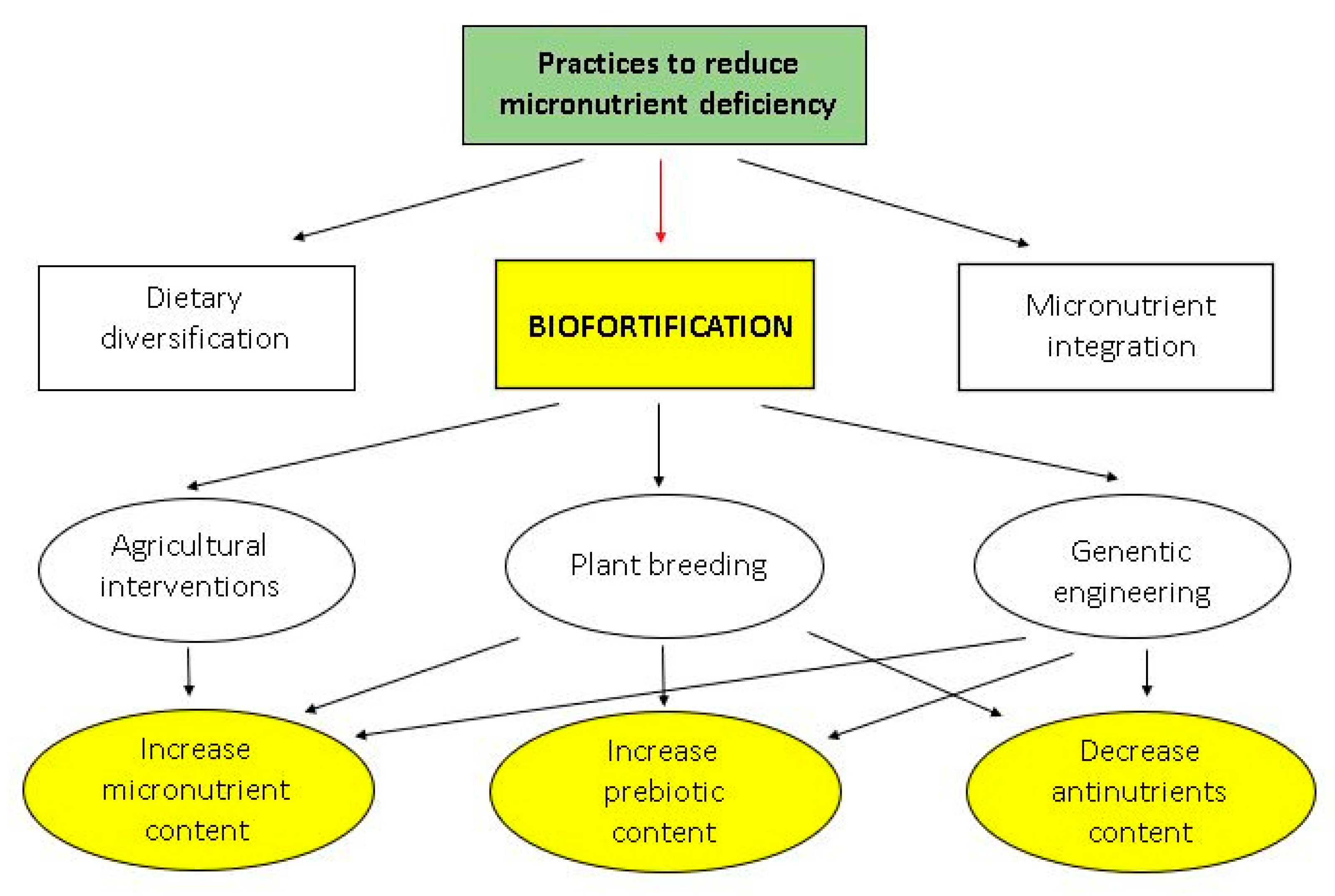
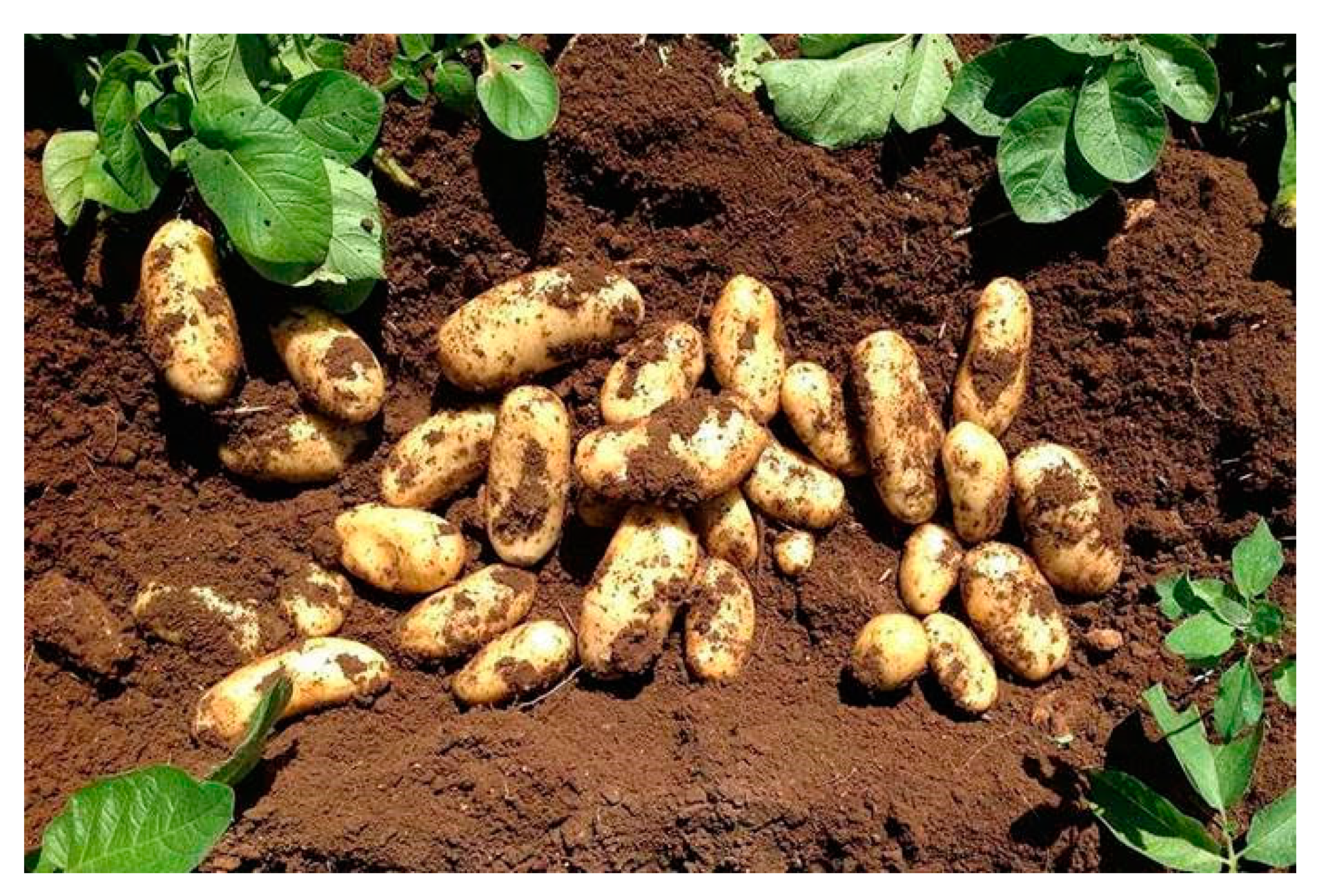
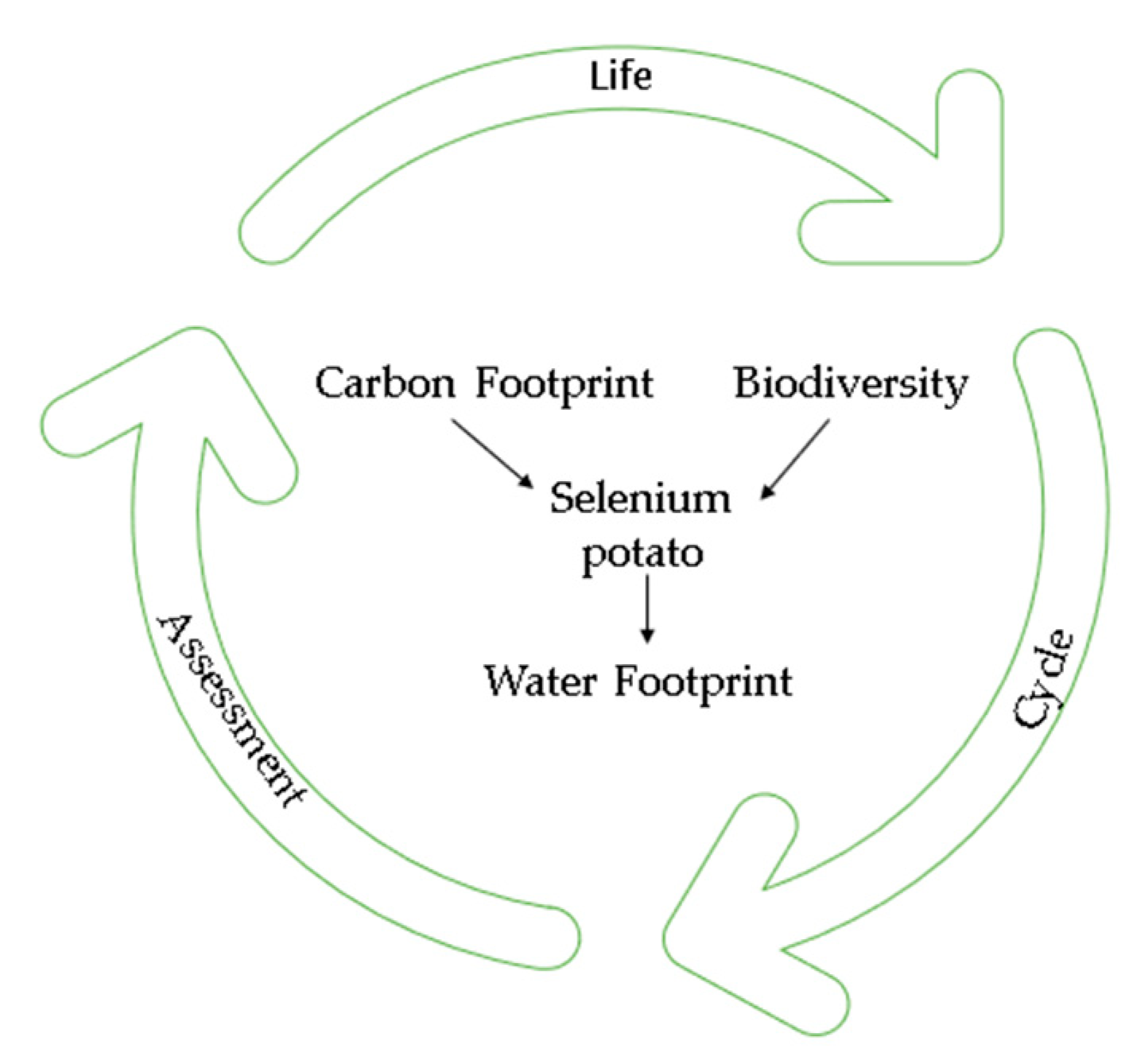
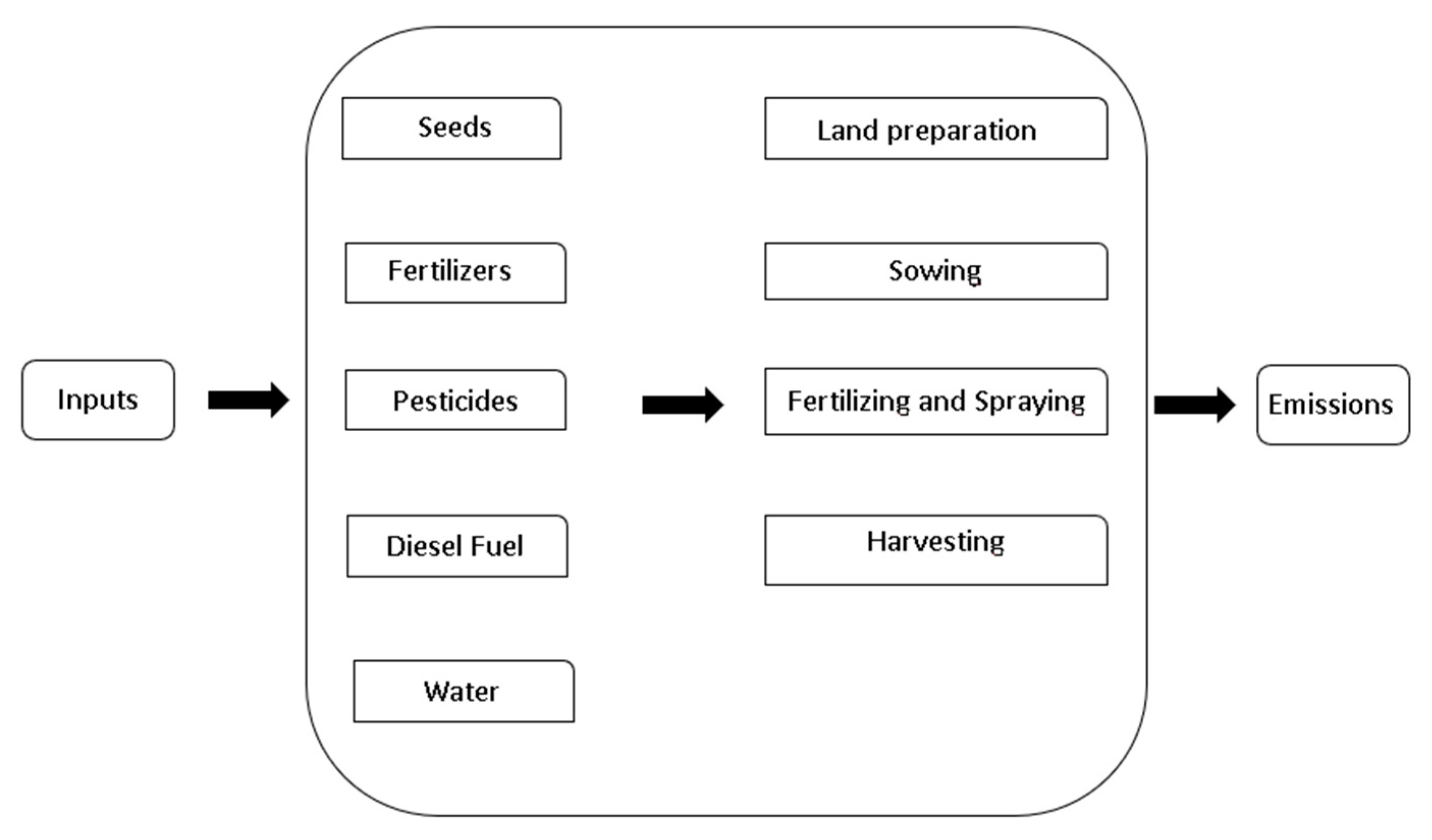
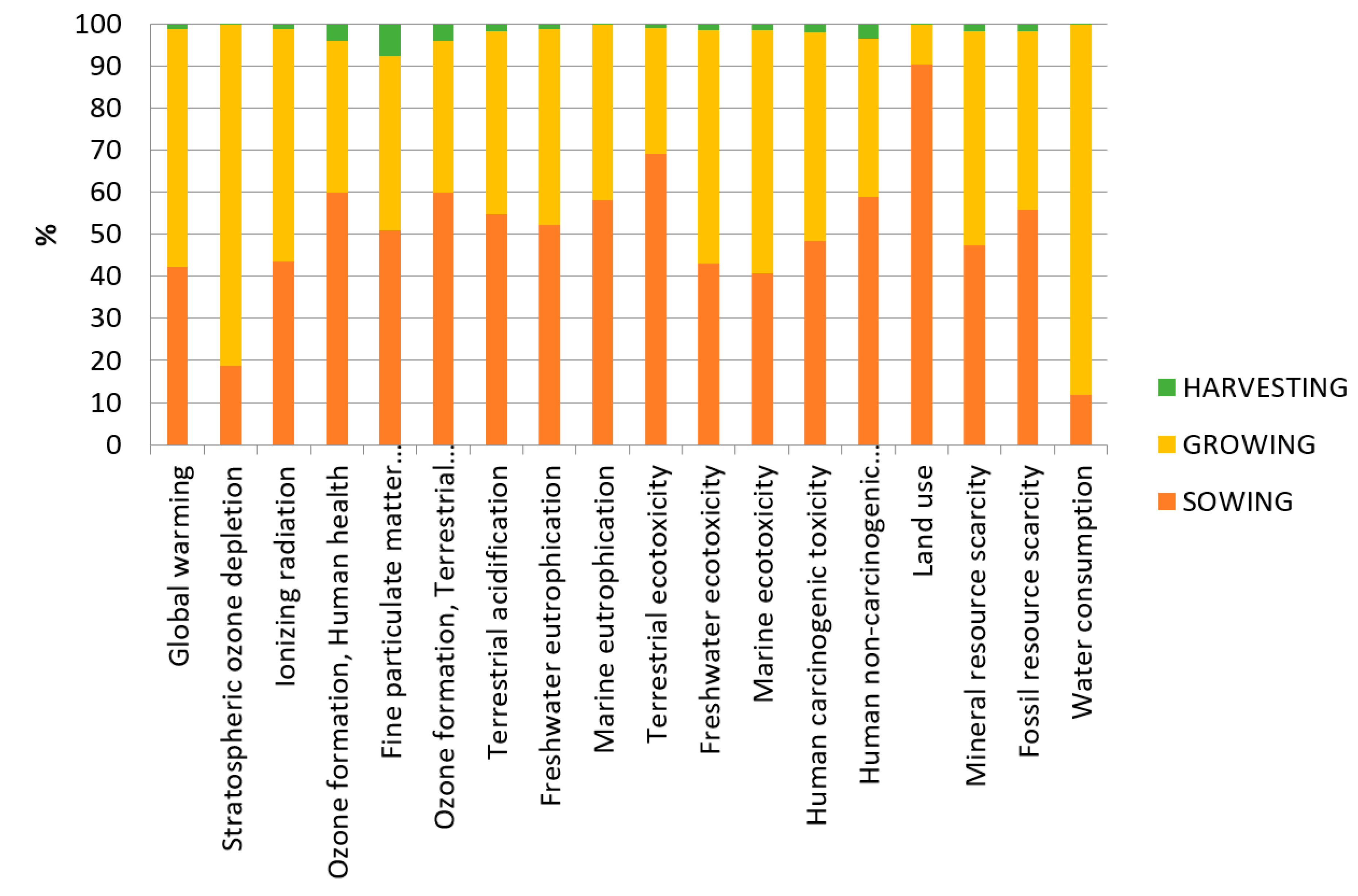
| Measurement Units | Definition |
|---|---|
| kg CO2 eq | kg carbon dioxide equivalent |
| kg CFC11 eq | kg freon-11 equivalent |
| kBq Co-60 eq | kBq cobalt-60 equivalent |
| kg NOx eq | kg nitrogen oxide equivalent |
| kg PM2.5 eq | kg of particulate matter equivalent |
| kg SO2 eq | kg sulfur dioxide equivalent |
| kg P eq | kg phosphorus equivalent |
| kg N eq | kg nitrogen equivalent |
| kg 1,4-DCB | kg 1.4-dichlorobenzene equivalent |
| m2a crop eq | area time (crop) equivalent |
| kg Cu eq | kg copper equivalent |
| kg oil eq | kg oil equivalent |
| m3 | cubic meters |
| Impact Category | Unit | P Se | P Conv | Difference % |
|---|---|---|---|---|
| Global warming | kg CO2 eq | 7584.8975 | 9384.7258 | −23.73 |
| Stratospheric ozone depletion | kg CFC11 eq | 0.1058336 | 0.1510982 | −42.77 |
| Ionizing radiation | kBq Co-60 eq | 173.72061 | 186.66713 | −7.45 |
| Ozone formation, human health | kg NOx eq | 27.854544 | 31.219681 | −12.08 |
| Fine particulate matter formation | kg PM2.5 eq | 17.107643 | 19.37635 | −13.26 |
| Ozone formation, terrestrial ecosystems | kg NOx eq | 28.274082 | 31.6718 | −12.02 |
| Terrestrial acidification | kg SO2 eq | 33.290309 | 42.953039 | −29.03 |
| Freshwater eutrophication | kg P eq | 1.8246778 | 1.8339521 | −0.51 |
| Marine eutrophication | kg N eq | 2.2722197 | 2.3203019 | −2.12 |
| Terrestrial ecotoxicity | kg 1,4-DCB | 51,387.258 | 57,943.158 | −12.76 |
| Freshwater ecotoxicity | kg 1,4-DCB | 545.14385 | 677.70278 | −24.32 |
| Marine ecotoxicity | kg 1,4-DCB | 665.66013 | 796.10175 | −19.60 |
| Human carcinogenic toxicity | kg 1,4-DCB | 179.5491 | 202.2912 | −12.67 |
| Human noncarcinogenic toxicity | kg 1,4-DCB | 11660.33 | 13,581.233 | −16.47 |
| Land use | m2a crop eq | 681.77309 | 673.79335 | 1.17 |
| Mineral resource scarcity | kg Cu eq | 85.130212 | 89.970775 | −5.69 |
| Fossil resource scarcity | kg oil eq | 1540.868 | 1803.6372 | −17.05 |
| Water consumption | m3 | 2489.3864 | 2519.9408 | −1.23 |
Publisher’s Note: MDPI stays neutral with regard to jurisdictional claims in published maps and institutional affiliations. |
© 2020 by the authors. Licensee MDPI, Basel, Switzerland. This article is an open access article distributed under the terms and conditions of the Creative Commons Attribution (CC BY) license (http://creativecommons.org/licenses/by/4.0/).
Share and Cite
Scuderi, A.; Cammarata, M.; Via, G.L.; Pecorino, B.; Timpanaro, G. Life-Cycle Assessment of Biofortified Productions: The Case of Selenium Potato. Appl. Syst. Innov. 2021, 4, 1. https://doi.org/10.3390/asi4010001
Scuderi A, Cammarata M, Via GL, Pecorino B, Timpanaro G. Life-Cycle Assessment of Biofortified Productions: The Case of Selenium Potato. Applied System Innovation. 2021; 4(1):1. https://doi.org/10.3390/asi4010001
Chicago/Turabian StyleScuderi, Alessandro, Mariarita Cammarata, Giovanni La Via, Biagio Pecorino, and Giuseppe Timpanaro. 2021. "Life-Cycle Assessment of Biofortified Productions: The Case of Selenium Potato" Applied System Innovation 4, no. 1: 1. https://doi.org/10.3390/asi4010001
APA StyleScuderi, A., Cammarata, M., Via, G. L., Pecorino, B., & Timpanaro, G. (2021). Life-Cycle Assessment of Biofortified Productions: The Case of Selenium Potato. Applied System Innovation, 4(1), 1. https://doi.org/10.3390/asi4010001






